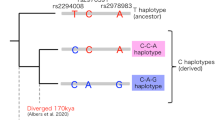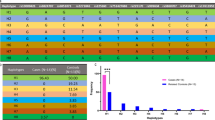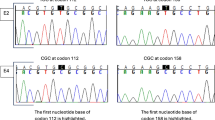Abstract
To clarify the population history of dentatorubropallidoluysian atrophy (DRPLA) in Italy and to date back the introduction of the mutation, we reconstructed extended haplotypes flanking the CAG repeat in 10 patients of Italian ancestry, analyzing their similarity/dissimilarity as a function of distance from the CAG repeat. Our aim was to compare the hypothesis of a single, recent genealogy connecting all the observed haplotypes with the alternative hypothesis of multiple introductions by more distantly related haplotypes from outer sources. Polymorphic DNA markers were chosen to cover a region of 153 kb flanking the CAG repeat, that is, informative for dating the age of the DNA segment unaffected by recombination. In all patients, an expansion of the ATN1 CAG segment was confirmed residing onto the same narrow haplotype described to be associated with the CAG expansion in the Japanese and Portuguese populations. We also observed the disruption of the DRPLA haplotype at longer distances, on both sides of the CAG. Our results are compatible with a single founder in the last 600 years, most likely before the last 270 years. These estimates for the Sicilian population largely overlap a period in which the Japanese haplotype with the DRPLA mutation could have been introduced by the Portuguese maritime travelers.
Similar content being viewed by others
Log in or create a free account to read this content
Gain free access to this article, as well as selected content from this journal and more on nature.com
or
References
Takano, H., Cancel, G., Ikeuchi, T., Lorenzetti, D., Mawad, R., Stevanin, G. et al. Close associations between prevalences of dominantly inherited spinocerebellar ataxias with CAG-repeat expansions and frequencies of large normal CAG alleles in Japanese and Caucasian populations. Am. J. Hum. Genet. 63, 1060–1066 (1998).
Nørremølle, A., Nielsen, J. E., Sørensen, S. A. & Hasholt, L. Elongated CAG repeats of the B37 gene in a Danish family with dentato-rubro-pallido-luysian atrophy. Hum. Genet. 95, 313–318 (1995).
Warner, T. T., Lennox, G. G., Janota, I. & Harding, A. E. Autosomal-dominant dentatorubropallidoluysian atrophy in the United Kingdom. Mov. Disord. 9, 289–296 (1994).
Cox, H., Costin-Kelly, N. M., Ramani, P. & Whitehouse, W. P. An established case of dentatorubral pallidoluysian atrophy (DRPLA) with unusual features on muscle biopsy. Eur. J. Paediatr. Neurol. 4, 119–123 (2000).
Connarty, M., Dennis, N. R., Patch, C., Macpherson, J. N. & Harvey, J. F. Molecular re-investigation of patients with Huntington's disease in Wessex reveals a family with dentatorubral and pallidoluysian atrophy. Hum. Genet. 97, 76–78 (1996).
Becher, M. W., Rubinsztein, D. C., Leggo, J., Wagster, M. V., Stine, O. C., Ranen, N. G. et al. Dentatorubral and pallidoluysian atrophy (DRPLA). Clinical and neuropathological findings in genetically confirmed North American and European pedigrees. Mov. Disord. 12, 519–530 (1997).
Silveira, I., Miranda, C., Guimarães, L., Moreira, M. C., Alonso, I., Mendonça, P. et al. Trinucleotide repeats in 202 families with ataxia: a small expanded (CAG)n allele at the SCA17 locus. Arch. Neurol. 59, 623–629 (2002).
Martins, S., Matamá, T., Guimarães, L., Vale, J., Guimarães, J., Ramos, L. et al. Portuguese families with dentatorubropallidoluysian atrophy (DRPLA) share a common haplotype of Asian origin. Eur. J. Hum. Genet. 11, 808–811 (2003).
Muñoz, E., Milà, M., Sánchez, A., Latorre, P., Ariza, A., Codina, M. et al. Dentatorubropallidoluysian atrophy in a spanish family: a clinical, radiological, pathological and genetic study. J. Neurol. Neurosurg. Psychiatry 67, 811–814 (1999).
Pujana, M. A., Corral, J., Gratacòs, M., Combarros, O., Berciano, J., Genís, D. et al. Spinocerebellar ataxias in Spanish patients: genetic analysis of familial and sporadic cases. The Ataxia Study Group. Hum. Genet. 104, 516–522 (1999).
Destée, A., Delalande, I., Vuillaume, I., Schraen-Maschke, S., Defebvre, L. & Sablonnière, B. The first identified French family with dentatorubral-pallidoluysian atrophy. Mov. Disord. 15, 996–999 (2000).
Villani, F., Gellera, C., Spreafico, R., Castellotti, B., Casazza, M., Carrara, F. et al. Clinical and molecular findings in the first identified Italian family with dentatorubral-pallidoluysian atrophy. Acta. Neurol. Scand. 98, 324–327 (1998).
Casseron, W., Azulay, J. P., Broglin, D., Kaphan, E., Genton, P., Le Ber, I. et al. Phenotype variability in a caucasian family with dentatorubral-pallidoluysian atrophy. Eur. Neurol. 52, 175–176 (2004).
Le Ber, I., Camuzat, A., Castelnovo, G., Azulay, J. P., Genton, P., Gastaut, J. L. et al. A prevalence of dentatorubral-pallidoluysian atrophy in a large series of white patients with cerebellar ataxia. Arch. Neurol. 60, 1097–1099 (2003).
Brusco, A., Gellera, C., Cagnoli, C., Saluto, A., Castucci, A., Michielotto, C. et al. Molecular genetics of hereditary spinocerebellar ataxia: mutation analysis of spinocerebellar ataxia genes and CAG/CTG repeat expansion detection in 225 Italian families. Arch. Neurol. 61, 727–733 (2004).
Aridon, P., Tarantino, P., Ragonese, P., D'Amelio, M., Cinturino, A., Salemi, G. et al. Dentatorubral-pallidoluysian atrophy: haplotype of Asian origin in 2 Italian families. Mov. Disord. 27, 460–4611 (2012).
Yanagisawa, H., Fujii, K., Nagafuchi, S., Nakahori, Y., Nakagome, Y., Akane, A. et al. A unique origin and multistep process for the generation of expanded DRPLA triplet repeats. Hum. Mol. Genet. 5, 373–379 (1996).
Nagafuchi, S., Yanagisawa, H., Sato, K., Shirayama, T., Ohsaki, E., Bundo, M. et al. Dentatorubral and pallidoluysian atrophy expansion of an unstable CAG trinucleotide on chromosome 12p. Nat. Genet. 6, 14–18 (1994).
Ye, J., Coulouris, G., Zaretskaya, I., Cutcutache, I., Rozen, S. & Madden, T. L. Primer-BLAST: a tool to design target-specific primers for polymerase chain reaction. BMC Bioinformatics 13, 134 (2012).
Excoffier, L., Laval, G. & Schneider, S. Arlequin (version 3.0): an integrated software package for population genetics data analysis. Evol. Bioinform. Online 1, 47–50 (2007).
Spencer, C. C. & Coop, G. SelSim: a program to simulate population genetic data with natural selection and recombination. Bioinformatics 20, 3673–3675 (2004).
Vale, J., Bugalho, P., Silveira, I., Sequeiros, J., Guimarães, J. & Coutinho, P. Autosomal dominant cerebellar ataxia: frequency analysis and clinical characterization of 45 families from Portugal. Eur. J. Neurol. 17, 124–128 (2010).
Acknowledgements
The work was partially supported by grant PRIN-MIUR 2009P2CNKK_003 to AN.
Author information
Authors and Affiliations
Corresponding author
Ethics declarations
Competing interests
The authors declare no conflict interest.
Rights and permissions
About this article
Cite this article
Veneziano, L., Mantuano, E., Catalli, C. et al. A shared haplotype for dentatorubropallidoluysian atrophy (DRPLA) in Italian families testifies of the recent introduction of the mutation. J Hum Genet 59, 153–157 (2014). https://doi.org/10.1038/jhg.2013.137
Received:
Revised:
Accepted:
Published:
Issue date:
DOI: https://doi.org/10.1038/jhg.2013.137
Keywords
This article is cited by
-
DRPLA: understanding the natural history and developing biomarkers to accelerate therapeutic trials in a globally rare repeat expansion disorder
Journal of Neurology (2021)
-
A reference haplotype panel for genome-wide imputation of short tandem repeats
Nature Communications (2018)



